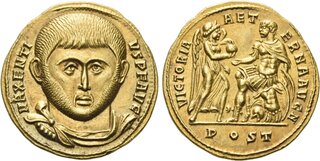| Numismatica Ars Classica > Auction 146 | Auction date: 8 May 2024 |
| Lot number: 2396 Price realized: This lot is for sale in an upcoming auction - Bid on this lot  | Show similar lots on CoinArchives Find similar lots in upcoming auctions on |
| Lot description: Maxentius augustus, 307 – 312. Aureus, Ostia circa 310-312, AV 19 mm, 5.24 g. MAXENTI – VS P F AVG Bare-headed, draped and cuirassed bust facing. Rev. VICTORIA AET – ERNA AVG N Victory advancing r. presenting globe to Maxentius, in military attire, seated l. on cuirass, extending his r. hand to receive globe and leaning l. on shield set on the ground. At emperor's feet, helmet and in exergue, P OST. C –. A. Baldwin Brett, NC 1933, 139 (2) and pl. XXVI, 7 (this coin). Beaurains 192 (this coin). Fred C. Albertson, Maxentian hoards and the Ostia Mint, ANSMN 30, 1985, pl. 40, 7 (these dies). Biaggi 1918 (this coin). Jameson 476 (these dies). Kent-Hirmer 615 (these dies and this coin cited). RIC 10 (this coin). Evans, Some notes on the Arras Hoard, in NC 1930, p. 273 (this coin cited). Depeyrot 1/10. Calicó 5080 (this coin). Of the highest rarity, only two specimens known. Undoubtedly one of the most important and impressive Roman aurei. A spectacular and innovative portrait struck on a full flan and with a magnificent reverse composition. Lovely reddish tone, virtually as struck and almost Fdc Ex Ars Classica XVII, 1934, Sir Arthur Evans, 1876; Leu 22, 1979, 378; Sotheby's 4 December 1990, 103 and Sotheby's 5 July 1995, 178 sales. From the L. Avot collection and from the Arras Hoard. This coin is illustrated in The Roman Aurei by X. E. Calicó. Facing portraits were not a regular feature of Roman coinage until late in the Constantinian Era, and even then were only produced in quantity at Eastern mints. On very rare occasions, facing busts were issued in the West in earlier times, and we may be certain that in each case the circumstances were special. Some of those issues were struck at Rome and Ostia in the name of Maxentius, whose propaganda was steeped in tradition rather than innovation, which makes his facing-head coins all the more remarkable. This aureus is a remarkable object that not only ranks among the most desirable of all Roman coin types, but is also beautifully preserved and comes from the fabled Arras Hoard. For precedents we can hardly look to the obscure facing-bust coinages of Postumus or Carausius, and we might presume the facing-head issues of Maxentius were inspired by sculpture in the round. These arresting coins made a strong impression on contemporaries, as both Tetrarchic finalists, Licinius and Constantine I, later struck their own facing-head aurei and medallions. The innovation may not have been Maxentius' at all, but that of a gifted engraver. Fred C. Albertson, in his "Maxentian Hoards and the Mint at Ostia" (ANSMN 30), suggests the engraver of this pair of dies had been the chief die engraver and designer at Rome before he was transferred to Ostia. For this reason, and a host of other issues of style and fabric, he rejects Carson and Kent's idea that the new mint was founded by personnel from the recently closed Carthage mint. Scholars have long puzzled over the founding of Maxentius' new mint at the harbour town of Ostia in 308/9. Various theories have been offered, but most likely it was founded to supplement production at Rome, and to diversify coining activities in the region. The politically charged environment in the capital no doubt made it advisable to mint at least part of the regional coinage outside the Aurelian Wall. Ostia offered the advantage of close proximity, good fortification, and fast access to the sea if evacuation was necessary. The date of this aureus and other closely related issues from Ostia is still a matter of debate. Depeyrot suggests 310-312 and Kent suggests 308 (presumably late in the year) as what would have been an inaugural issue. Bastien and Metzger consider it to have been struck late 310 or 311 as a quinquennelia issue. Brett placed it in the first half of 311 and, largely because of its reverse inscription VICTORIA AETERNA AVG N ('the eternal victory of our emperor'), described it as a celebration of the recovery of Africa from the rebel Alexander of Carthage. Though the date of Alexander's defeat is not certainly known, it likely occurred in the summer or winter of 310. Estimate: 500000 CHF |  |



